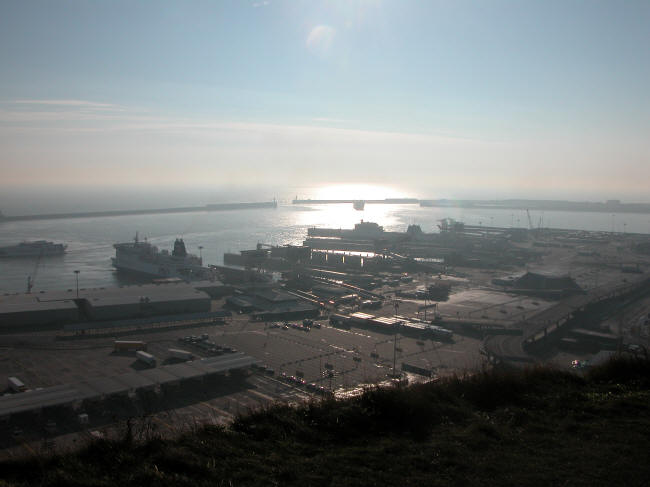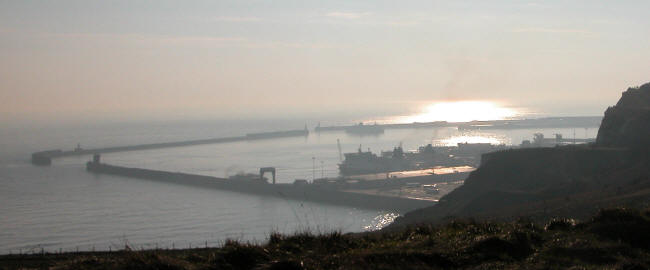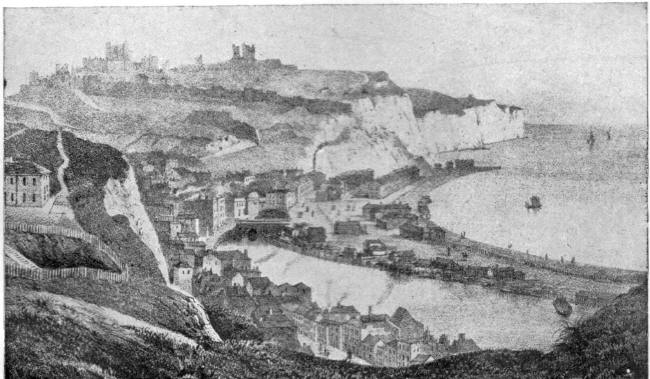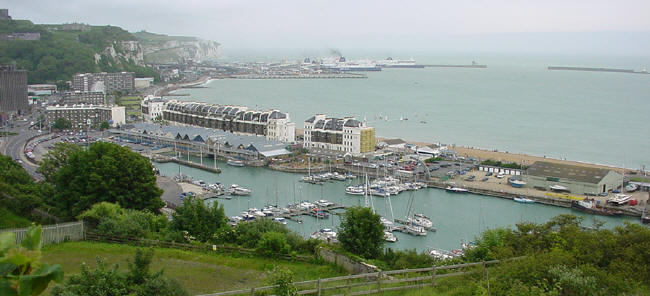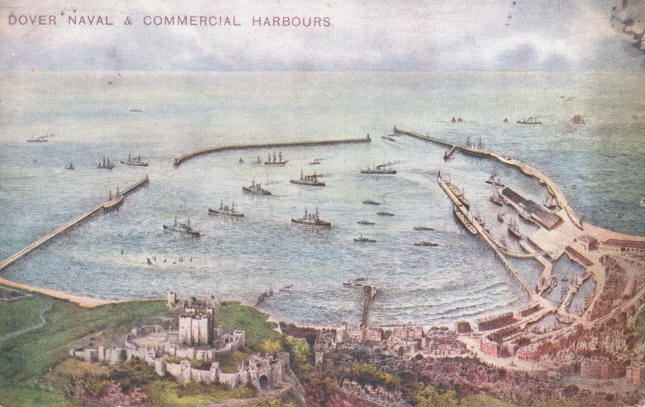The Admiralty Harbour |
|
|
|
|
DOVER HARBOUR Those of my readers who have already read "A.T.R.M." (And That Reminds Me) will remember that in pre-war days, after my retirement from active service, I resided for a period of three years in Dover. Being debarred at the time from anything like strenuous exercise, owing to the injury to my foot, I originated and started a small 14-foot class of sailing dinghies which we used to race every Saturday. They were very smart little boats with the centre-boards, and being all built on the one model, were as alike as split peas and, properly weighted and properly ridden, it was - or rather should have been - on any sort of a day anybody's race. But it never was. There was only one man in it, and it wasn't I. Put him at the helm of any one of the boats we had in commission, and it was the Bank of England to a Hun herring that the particular boat was first across the line at the winning post. But then, you see, he was the only one of the lot of us who had any experience of the vagaries of the tides in the Dover Harbour. I have a much more practical and intimate acquaintance with it now. It is commonly estimated that the Dover Harbour stands the country about six million pounds sterling. If it had cost double that sum it would have been worth every penny of it during the present war, but nothing can convince me that a better, safer, and more useful harbour could not have been selected elsewhere, either to the eastward in the vicinity of Deal-Margate, or to the westward near Dungeness. The site was selected and the harbour constructed in the bad, mad and sad days of Party Politics, never, let us hope, to be tolerated again in the future. I much fear me that the double rail-head coming, as it did, to Dover, was the main consideration which weighed with the authorities at the time. It was a Conservative Government that built it and a Radical Government that starved it, with the result that when war was suddenly declared the Dover Harbour was found wanting. Now I am not blaming anybody in particular, least of all any Board of Admiralty, for I have some knowledge of how these schemes are settled in peace-time, without the advice, and frequently against the advice, of the professional experts; but you would have thought that, giving the place the grandiloquent title of "Admiralty Harbour of Dover," the Government would have taken the obvious precaution to secure sufficient land round about it to construct the thousand and one buildings, storehouses, and workshops so essential for a naval harbour and war base. Not a bit of it, and it will, I suppose, hardly be believed when I say that when war broke out not only were the essentials most inadequate, but, to give one instance alone, there was not a single mechanical crane in Dover capable of lifting over four tons, and none at all belonging to the Admiralty. And for the want of this accommodation for all the necessary requirements, Dover itself must take its fair share of responsibility. I can remember years ago when any attempt at securing more room by the suggestion of pulling down a few worn-out workmen's cottages in the vicinity of the pier was met by a howl of indignation by the local Press, and by the people. Later, when a most sensible scheme was brought forward for the enlargement of the local docks - which, had it gone through, would have been of inestimable value during the war - it was flouted and condemned as a means only to browbeat the poor and enrich the rich. The town could do nothing to assist at the eastern end of the harbour, for there you are up against a steep cliff with only sufficient room for the construction of the few vital requirements of the Dover Patrol as it existed before the war; but, at the other or pier end, the local authorities could have helped substantially had they wished to do so. I wonder what a German Government would have done in similar circumstances? No doubt, by an executive order, the greater portion of the town would have been razed to the ground to provide the accommodation required for the purposes of the "All Highest," and any protest rigidly "verboten." No, the people of Dover have failed so far to realize the fact that the construction of the harbour has ruined the place as a residential resort. It has ruined the sea front, it has ruined the sea bathing, and it has ruined the sea view, and the sooner they give up all idea of attempting to attract people to a place where there are no longer any attractions, the sooner they will be able to set their house in order and develop their town into the successful commercial and coaling centre which it is likely to become in the near future. As things stand at present, the failure to look ahead has cost the nation an enormous amount of money, inasmuch as, from the Admiral downwards, each department has from the start attempted the impossible task of making bricks without straw. Every day things have to be improvised, begged, borrowed or stolen, and the marvel to me is not that things have gone so well, but that they have gone on at all without a serious accident or breakdown. To attempt to justify my remarks about the injudicious selection of the site for this harbour, let me for a moment try and explain how it is the tides and the sea here are so troublesome and dangerous. If you look at a map it will be seen that these islands are washed and served by two different seas: to the east by the English Channel, which flows into the North Sea or "English" (late "German") Ocean, and to the west by the Atlantic Ocean. During the flow of the flood tide they both work up on either side of us in a north-easterly direction, but the tide to the west being a much heavier volume of water, when it reaches the north of Scotland, it works around the headland and forces down the weaker stream - which till then had been working in a parallel direction - until such time as the latter is able to assert itself. This point is somewhere just west of Dover, and at the psychological moment of the turn you have a slow expiring stream turned suddenly into a strong flood tide and driving in the opposite direction at a rate of from three to four knots, which at spring tides and with a south-westerly gale blowing, is frequently increased even up to as much as five and a half. To realize the consequences, you have only to turn to the plan of the harbour and study the position of the two entrances. The first spring of this released tide sweeps with a rush into the western entrance, and at the same time swirls along outside the wall of the southern breakwater, where it seeks a fresh inlet round the corner at the eastern entrance. It then stands to reason that these two in-rushes, one from the east and the other from the west, must meet somewhere inside the harbour, with the result that if you happen to be there in a T.B.D. at that particular moment, nosing around for your mooring buoy, you know all about it. Some of the craft in the Dover Patrol have had bumps, and in fact I will admit that many of them have had, but the mystery to me is not the number of bumps and collisions they have had, but the fact that not one of them so far has been lost. It's bad enough in heavy weather in the daytime, but remember they have to be on their patrol duties day and night, and nothing must ever stop them. It's war-time and Fritz is not the man to be ignorant of our difficulties or to fail to take advantage of the opportunity, should he be allowed to get it. I know of one case where a full-powered T.B.D. - one of our best and in the hands of our ablest skippers, Lt.-Comr. John Brooke, D.S.C., R.N. - took two and a half hours trying to get his ship fast to a buoy, lost a man in the attempt, rescued him, and then had to give it up and run to the Downs for a safe anchorage! And, mind you, many of these men in command of our 1000-ton destroyers are youngsters who, in my sea-days, would not have been trusted to take anything beyond an amplitude or an azimuth, and possibly, by way of a treat, an occasional well-diluted gin and bitters! And I am not talking of what I do not know when I say that it is due to their fearless dash, and superb handling of their craft, that we have so far escaped anything in the shape of a disaster in this the worst of harbours ever constructed for the safety of ships. Being beaten in the past days of sailing every time I met him by the gentleman already referred to, I endeavoured to learn, by close personal study, something of the working of the tides in the harbour; but I regret to say that even now I am no expert, and I don't believe one exists, for the tides change direction with every change of wind. But I certainly did prove one thing, and that was this fact: with a four to five-knot stream running outside the breakwater to the eastward, I have in my little dinghy, without oars or sails, drifted down inside the same wall in the opposite direction at the rate of one and a half miles an hour. Imagine what this may mean in a gale of wind and a heavy sea, when you are either making or leaving the harbour at the western entrance! And to prove that I am not talking altogether through my hat regarding to the difficulties on has to face here, I would ask leave to quote one or two of my experiences of the havoc which the wind and sea can work, in this so-called "haven of rest." I will start with one of the most marvellous feats ever performed by a ship "on its own." Finding the boom defences of the Dover Harbour were not adequate owing to the great strength of the tides, it was decided that, while altering the system for the eastern entrance, the only safe and quick method dealing with the western entrance would be by sinking craft on each side of it, by means of which the sunken vessel to the eastward would protect the Outer or Admiralty Harbour from submarine or torpedo attack, and that to the westward would provide similar protection to that portion of the harbour known locally as the Commercial Harbour, which leads to the inner docks. For this purpose two ships of large size were selected: the s.s. Montrose and the s.s. Spanish Prince, both old Atlantic liners of from 10,000 to 12,000 tons. And it is to the first two ships, the Montrose - celebrated, as all will remember, for the capture of Crippen, the murderer, with his female accomplice, while fleeing from justice to America - that the incident occurred. The ship had been gutted of everything, and cut down to the main deck, and in place of the masts, funnels and all deck gear, she had been fitted with large iron super-structures on which to hang the torpedo netting. In fact, some lengths of this netting had already been stretched across, and it was no doubt in part due to this that the accident occurred. On December 28th, 1914, the Montrose was completed and moored alongside the extreme end of the Admiralty Pier in readiness for placing in position and sinking the following day. She was lying here moored with several six-inch steel wire hawsers fore and aft, and three twenty-two inch coir ropes, in addition to long scopes of her own chain cable at either end. About 6.30 p.m. that night, a very heavy south-westerly gale sprang up very suddenly, accompanied by a tremendous sea, which, breaking over the breakwater, overturned loaded railway trucks on the pier and fell in large volume on the deck of the Montrose. Added to this, a heavy swell coming in from the western entrance caused the ship to range heavily, and by 10.30, to the horror and alarm of everybody, it was reported that this huge 12,000-ton ship, with only two men on board, had broken adrift in the middle of a dark and stormy night, with the harbour crammed full of shipping. The matter was at once reported to Commander Bevan, R.N., the Assistant King's Harbour Master, who was in charge of the boom defence operations, and he had an exciting experience as a result. Hastily shoving on a pair of heavy sea boots and oilskins, he rushed from his office down the Prince of Wales Pier to board one of his tugs, with a view to getting to the Montrose. He had ordered his tug to come to the lee or east side of the pier, but fortunately for him when he got there she was not actually alongside, for in stooping to go down the iron foot-ladder a furious gust of wind caught him and blew him overboard. Had the tug been there he must have been killed; as it was, he was very nearly drowned. In the meantime, it had been ascertained that the two men on board the Montrose, realizing their danger, had managed to escape before the ship broke loose. And what had happened to the ship? I the first place she was set half-way through the western entrance; then, the tide catching her, she was flung back and brought up momentarily alongside the southern breakwater. Gaining impetus from the wind and tide, her progress along the wall could be seen simply from the sparks of fire caused by her steel sides rubbing along the stone wall of the breakwater. On she went through the battleships, cruisers, destroyers, trawlers, and drifters without touching one of them, and yet only missing some by inches. On again through the eastern entrance with the same thoughtfulness; thence close in shore past St. Margaret's Bay, the South Foreland, across the West Goodwins, and finally, finding a nice, soft, sandy spot, she settled herself down for her long-earned peace and rest on the extreme edge of the East Goodwin! It is almost impossible to conceive this huge ship negotiating, as if by instinct, the numerous shoals and traps to be found all along the course she took on this her last and truly amazing journey. And if only the Hun had come along that night and brought her to action? Cannot you imagine how the "Blighters of Berlin" would have howled their hymn of hate and screeched their gibes of joy at the total destruction of the latest thing in British super-Dreadnoughts, with the loss of every soul on board, after a prolonged engagement with a German motor boat! And yet in this instance they would have been nearer the truth than most of their flamboyant naval claims. Many attempts were made the next day with powerful tugs to pull the Montrose off, but she wasn't taking any. She had settled herself down for her last long sleep, to a depth of two feet in the sand, and two days later, another gale springing up, she broke in half. It was ascertained beyond doubt that the break away of the Montrose was more due to the sea in the harbour causing the "ranging" of the ship, than to the wind. Had the wind alone been at fault, one would have found all the moorings snapped like fiddle strings; but only two six-inch wires were so broken, while four huge iron bollards, used for fastening the moorings to, were torn bodily out of the ship and recovered as part of the salvage from the wreck on the Goodwins. In place of the lost Montrose, the s.s. Lavonia, a similar sort of ship, was next taken in hand, and towards the end of December she was completed and ready for sinking. Bad weather again accounted for a delay of ten days, during which time, while she was lying at a buoy in this haven of rest, she had her windlass damaged by strain, and later the bollards, to which the cable had been taken, were also started by a heavy swell of the sea. An opportunity offering, the Labonia was loaded with 5000 tons of sand ballast, and eventually, when all was ready, she was taken into position. Then with wires out on both sides and five or six powerful tugs in position, the word was given, the sea-cocks were opened and the great ship quietly submerged herself in forty feet of water "low spring tides," exactly four hours after commencing the operation. Suction dredgers then took her in hand, filling each hold separately with silt and sand which had been previously deposited in the bottom of the harbour for the purpose, thereby completing the job of making a solid and immovable mass of her. The s.s. Lavonia was sunk within a few inches of the exact spot selected, and she has not moved since. In the same month the s.s. Spanish Prince was similarly treated, and on the 10th February was sunk to the westward of the south arm. On the 1st March the huge steel curtain between the ends of the two ships which, by the simple means of lifting and letting down, forms the actual door of the entrance, was also in position, and the defence of this entrance completed and made good. I may mention that while Commander Bevan was the naval officer in charge of these defence works, Messrs. W. Pearson & Co. were the engineers and constructors, and the greatest credit is due to all concerned for the manner in which the work was done.
|
The Admiralty Harbour was eventually abandoned as a base by the navy because it was too vulnerable to attack by submarines and aeroplanes, as well as shelling from the French coast.
The Spanish Prince was removed during the 1950s and '60s; the Lavonia will need to be removed as part of the proposed new development of the Western Docks.
Large areas of the eastern side of the harbour have been reclaimed to provide berthing facilities for the roll-on-roll-off car-ferries which now ply the short sea routes to France and Belgium.
The docks (part of the old commercial harbour) have been turned into a marina for private yachts and motor cruisers.
